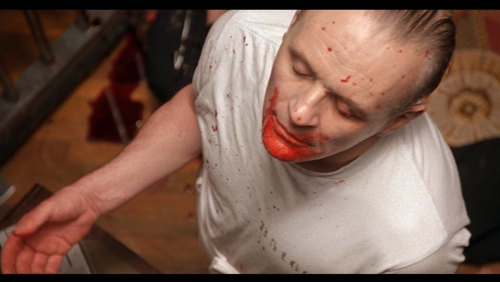The word “taboo” comes from the Tongan tapu or Fijian tabu. The term was translated as meaning “forbidden, cursed, or unclean.” The word has been expanded to relate to any area of human activity or custom that is forbidden based on societal norms, moral judgment and religious beliefs.
Film has long challenged societal taboos, pushing the envelope and disrupting what society deems proper and acceptable. Over time, however, the shock of the new is no longer shocking and taboos become commonplace. Here are 10 films that broke cinematic taboos:
1. Women in Love – First Male Full Frontal Nudity
Women in Love (1969), adapted from D.H. Lawrence’s novel of the same name, is considered by many to be the Holy Grail of male nudity in cinema. Full-frontal shots and explicit homoeroticism are featured during a naked wrestling match between Oliver Reed and Alan Bates.
2. Peeping Tom – First Naked Woman

In the mid 1930s, documentaries about indigenous peoples depicting naked women slowly found their way into the U.K. and the U.S., but Michael Powell’s Peeping Tom (1960) depicted nudity in larger cinema when Pamela Green’s character exposing a breast before she is killed. Powell was the first English-language director to try this and his career was nearly ended by the controversy surrounding this film.
3. Bonnie and Clyde – First Blood Soaked Shooting

The ending of Bonnie and Clyde (1967) is considered by many to be one of the first bloodiest and gruesome death scenes in cinema. At the time, the film was controversial due to its graphic violence and glorification of murder.
Bonnie and Clyde depicted someone getting shot in the face and at the end, the movie shows Bonnie and Clyde shot multiple times with bullets, leaving their clothes shredded from the violent encounter.
4. Psycho – First Toilet Flush
Before Psycho in 1960, toilets were missing from mainstream American cinema. Hitchcock wanted to show a toilet in a couple of his films but censors wouldn’t allow it. He finally got his way in Psycho where the first ever flushing of a toilet appeared in a Hollywood film. This film is taboo breaking not only because of the brutal murder and Marian’s crime, but because Hitchcock showed what is usually censored. Additional taboo breaking scenes includes killer Norman Bates cross-dressing as his mother and the naked Marian being stabbed to death in a shower.
5. Gimme Shelter – First Real Death
Many films have death scenes; however, in The Rolling Stones concert at The Altamont Raceway, this death was real. Meredith Hunter was stabbed to death by the Hells Angels, who were providing security for the concert. In Gimme Shelter, a member of Hells Angels is seen stabbing Hunter several times in the back. Reasons for the stabbing are mixed. Some say Meredith Hunter’s death was fueled by racial hated because Hunter, a black man, came to the concert with a white woman and was the subject of racial hated by the Hells Angels. Others accounts say Hunter’s death was self-defense when Hunter attempted to storm the stage clutching a revolver.
6. Ecstasy – First Sex Scene in a Non-Pornographic Film
Ecstacy (1933) contains two taboo breaking scenes: In the first, Hedy Lamarr swims naked in a lake. In the second, she has sex, in what is believed to be the first depiction of female orgasm in a non-pornographic film.
7. Doctor X – First Use of Cannibalism as a Plot Device
Cannibalism is one of society’s darkest taboos. From The Texas Chainsaw Massacre to Silence of the Lambs, the eating of human flesh is a unique genre in horror films. Doctor X (1933) is the first film to use cannibalism as a plot device. In the film, reporter Lee Taylor investigates a series of murders involving cannibalism.
8. Fireworks – First Openly Gay Character
Homosexuality was depicted in Hollywood and European films from the 1920s to the 1940s, but was only suggested or implied, and never meant for mainstream cinema. That is until Fireworks (1947) a movie about a closeted young gay man.
9. The Crying Game – First Transgender, Race, Sexuality and Identity Combo
The Crying Game (1992) is a psychological thriller exploring themes of race, gender, nationality, and sexuality. The main character, Fergus (Stephen Rea), as a member of the IRA. His brief but meaningful encounter with Jody (Forest Whitaker) leads him to an unexpected romantic relationship with Jody’s girlfriend, Dil (Jaye Davidson) who is a transexual woman. The way The Crying Game handles complex themes of identity, sexuality and human nature makes it one of my favorite films of the 90s.
10. A Clockwork Orange – First Pairing of Comedy and “Ultraviolence”
Stanley Kubrick’s A Clockwork Orange (1971) depicted the “ultra-violence” in Anthony Burgess’ book by the same name. This film is considered one of the most controversial films, but was nominated for a Best Picture Academy Award. The unorthodox artistic and graphic nature of the film was both praised and debated for its violence and drab outlook on the future. This film was also one of the first to pair comedy with “ultra-violence” – including two rape scenes.







